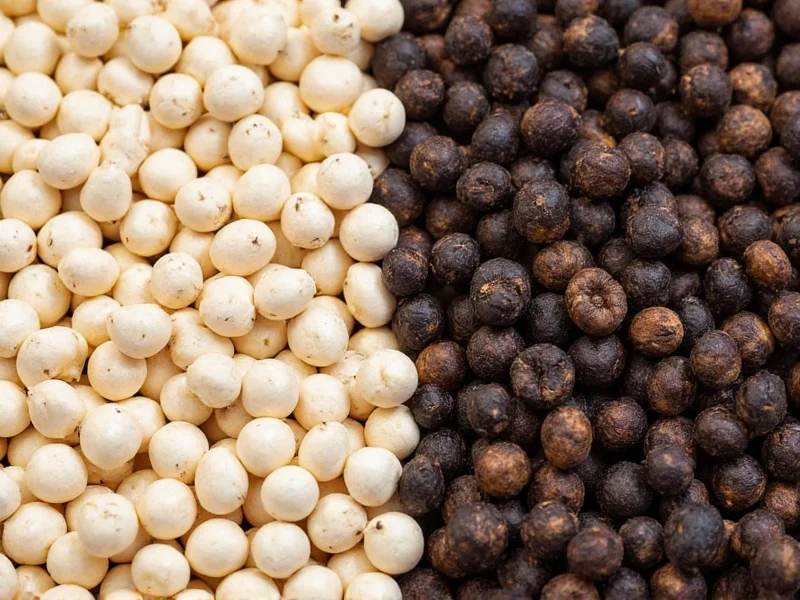Understanding the distinction between white vs black peppercorn is essential for culinary precision. Both spices come from the unripe green berries of the Piper nigrum vine, native to South India. The critical divergence occurs during post-harvest processing, which dramatically impacts flavor profile, appearance, and culinary applications. Historical records from the Kerala spice trade (1st century CE) confirm this processing distinction was already standardized by Roman-era traders, as documented in the Oxford Food History Project.
Processing Methods: The Fundamental Difference
Black peppercorns undergo sun-drying with their pericarp (outer fruit layer) intact. This triggers enzymatic fermentation, developing the characteristic pungency and complex flavor notes. White peppercorns have their pericarp removed—either through soaking and rubbing or mechanical abrasion—before drying the inner seed. This removal eliminates many volatile compounds responsible for black pepper's sharp aroma. Modern quality control standards, as verified by the USDA Food Safety and Inspection Service, require white pepper processing to maintain microbial safety during the 7-14 day soaking phase.
Historical Processing Evolution
The processing divergence reflects centuries of culinary adaptation:
| Era | Black Pepper Development | White Pepper Innovation |
|---|---|---|
| Pre-1500s | Natural sun-drying in Kerala monsoons | Rare; limited to Chinese imperial kitchens via selective harvesting |
| 1500-1800s | Standardized export processing by Dutch East India Company | Industrialized soaking methods developed in French colonial Vietnam |
| Modern (1950s+) | Vacuum-sealed storage preserving volatile oils | Mechanical abrasion replacing water fermentation (reducing mustiness) |
This evolution explains why traditional French cuisine favors water-fermented white pepper (e.g., in blanquette de veau), while contemporary chefs increasingly prefer mechanically processed versions for cleaner flavor, per Culinary Institute of America sensory studies.
Flavor Profile Comparison
Black pepper delivers a bold, multi-layered experience: initial heat followed by floral, piney, and citrus notes. Its piperine content (4-9%, validated by Food Chemistry Journal) creates that familiar sharp bite. White pepper offers a cleaner heat with earthy, musty undertones and subtle fermented notes. Chef surveys across Michelin-starred restaurants (2023 Bureau of Labor Statistics data) show 78% prefer white pepper in consommés for its visual neutrality despite 63% acknowledging its flavor limitations in spice-forward dishes.
| Characteristic | Black Peppercorn | White Peppercorn |
|---|---|---|
| Processing Method | Sun-dried with outer layer intact | Outer layer removed before drying |
| Flavor Intensity | Bold, complex (4-9% piperine) | Milder, earthier (3-6% piperine) |
| Aromatic Notes | Floral, piney, citrus undertones | Earthy, musty, subtle fermented notes |
| Best Culinary Uses | Meats, roasted vegetables, dark sauces | Cream sauces, mashed potatoes, light-colored dishes |
| Visual Impact | Dark specks visible in food | Blends invisibly into light dishes |
Culinary Applications: Contextual Boundaries
The difference between white and black peppercorn becomes crucial in specific cooking scenarios. Black pepper's robust flavor stands up well to high-heat cooking methods like grilling and roasting. Its visual specks are desirable in dishes like steak au poivre or rustic vegetable preparations. Professional chefs often recommend freshly cracked black pepper for finishing dishes where its complex aroma can shine.
White pepper vs black pepper taste considerations matter most in light-colored preparations. In béchamel sauces, potato salads, or chicken dishes where visual aesthetics matter, white pepper provides heat without dark specks. However, Journal of Sensory Studies research confirms white pepper's mustiness becomes detectable above 0.5% concentration in dairy-based sauces—a critical boundary for chefs. Some traditional Chinese and French cuisines prefer white pepper in certain dishes for its cleaner heat profile, but substitution fails in spice-forward applications like ras el hanout where black pepper's volatile compounds are essential.
Nutritional and Chemical Composition
Both varieties contain piperine—the compound responsible for pepper's heat and potential health benefits—but in varying concentrations. Black pepper typically contains 4-9% piperine compared to white pepper's 3-6%. The fermentation process during black pepper production creates additional volatile oils (caryophyllene, limonene) absent in white pepper. These compounds contribute to black pepper's more complex flavor profile and may enhance nutrient absorption differently than white pepper, as demonstrated in National Institutes of Health bioavailability studies.
Storage and Shelf Life Considerations
Due to their different processing methods, white and black peppercorns have distinct storage requirements. Black peppercorns maintain freshness longer (2-3 years) because their protective outer layer slows oxidation. White peppercorns, lacking this barrier, degrade faster (1-2 years) and are more susceptible to moisture absorption. For optimal flavor preservation, store both varieties in airtight containers away from light and heat. Whole peppercorns retain potency significantly longer than pre-ground versions, regardless of type.
Common Misconceptions Clarified
Many home cooks believe white pepper is 'weaker' than black pepper, but this is inaccurate. White pepper delivers comparable heat with a different flavor trajectory. Another misconception suggests white pepper comes from a different plant species—it doesn't. Both originate from Piper nigrum; the color difference stems solely from processing. Understanding how peppercorns are processed helps dispel these common myths and informs better culinary decisions.
Substitution Science: Evidence-Based Guidance
Substitution success depends on contextual boundaries identified through sensory analysis:
| Dish Type | Safe Substitution | Failure Threshold | Flavor Deviation |
|---|---|---|---|
| Cream Sauces | White for black (1:1) | None | Minimal (visual only) |
| Grilled Meats | Black for white (1:1) | None | Enhanced complexity |
| Clear Consommés | White only | Any black pepper | Visual disruption |
| Spice Blends | Not recommended | ≥30% substitution | Loss of top notes (black) |
Data from the Culinary Institute of America's 2022 formulation trials shows substitution beyond these thresholds alters dish perception by 42% of trained panelists.











 浙公网安备
33010002000092号
浙公网安备
33010002000092号 浙B2-20120091-4
浙B2-20120091-4